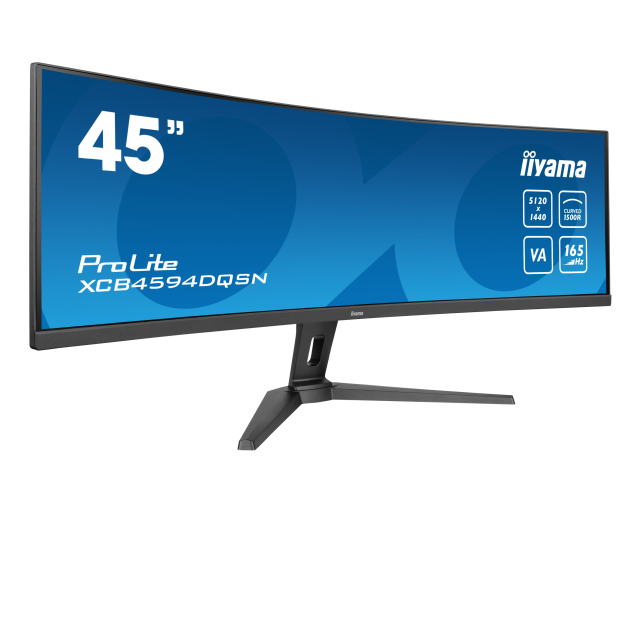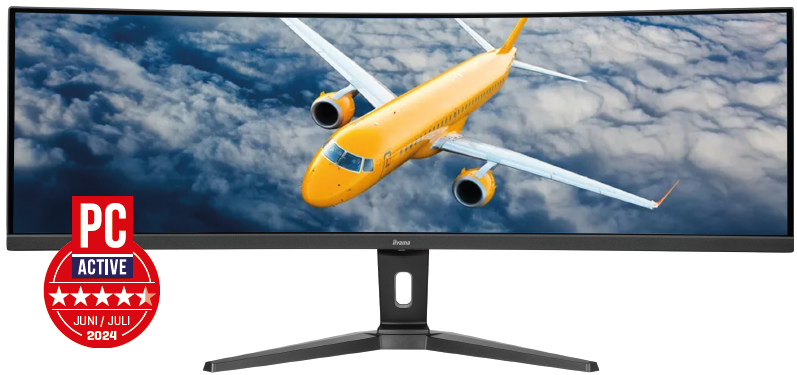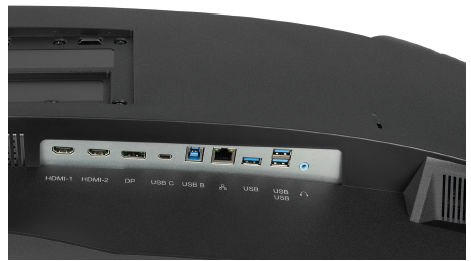
Monitors come in all shapes and sizes and this time we test the striking iiyama ProLite XCB4594DQSN with a super wide screen. What are the advantages and how good is this monitor?
Aad Munsterman
Every month PC-Active tests at least one monitor and this time it is the striking iiyama ProLite XCB4594DQSN. The width of 109 cm is the first thing that stands out: it is an ultra-wide curved 32:9 DQHD screen with a super resolution of up to 5120 x 1440 pixels and a curvature of 1500R to be able to see the image well across the entire width. The display is as if two 25 inch QHD screens have been seamlessly incorporated into one monitor screen.

DQHD ADVANTAGES
The advantages of this type of screen are legion, such as working with multiple tasks simultaneously with a continuous view of the output of those programs. It also offers a special experience when playing games. For the creative person, much more work space is available, such as a long video timeline, for faster and more efficient work. An additional advantage is a cleaner desk and a mouse pointer that moves smoothly over the entire screen. This type of screen therefore works strongly to increase production.
Disadvantages are a higher cost and the need for a powerful graphics processor such as a recent integrated or separate video controller with, for full resolution, an HDMI1.2 or DisplayPort connection. Another point of attention is that not all software can handle a 32:9 screen well.
PERFORMANCE
The monitor is black with three borderless sides and a screen diagonal of 44.5 inches or 113 cm. On the desk this requires a considerable space of 1090 x 409/539 x275 mm (wxhxd). The on/off button and OSD button (On Screen Display) are located at the bottom center of the screen.
SCREEN SPECIFICATIONS
The screen type is VA with a matte finish. This type is known for its high contrast with deep black levels and also good color reproduction and wide viewing angles. The contrast of this model has a value of 3000:1 and that is fine for most users. We measured the color reproduction and arrived at 100 percent sRGB, 78 percent NTSC, 80 percent AdobeRGB and 88 percent DCI-P3. These are good values for general use. The calibration of the screen is well done. The standard brightness can be reduced to 15 (120 nits). The viewing angles come out at the standard 178 degrees, whereby the curvature guarantees to display the image well across the entire width.
The brightness is a maximum of 450 nits. That is a nice maximum brightness for a monitor and suitable for most usage situations. HDR (High Dynamic Range) can be activated (for image information it provides) and will display a slightly better image than an SDR (Standard Dynamic Range). However, HDR400 is at the lower limit of what is possible with HDR.
The monitor has considerable gaming aspirations, as the MPRT (Moving Picture Response Time or the motion response time) has a value of 0.8 ms. This is a fast value to reduce motion blur. In gaming, the vertical sync frequency is also important and is between 48 and 165 Hz. In addition, Freesync adaptive sync is present for a variable refresh rate (VRR) to prevent pulling and stuttering of the image. This also makes this monitor a good candidate as a gaming screen.
VIDEO CONNECTIONS
A range of connections are available on the rear, including 2x HDMI2.0/2.1, 1x DisplayPort1.4 and 1x USB-C with DisplayPort alternate mode. The latter also supports Power Delivery and with 90 watts, so that a laptop can also be supplied with power via the same cable.
USB-C DOCK AND KVM SWITCH
A USB-C dock is built in, which uses the single USB-C cable between the system and the monitor. An RJ45 LAN port and the KVM switch are connected to this switch. In addition to the USB-C port, the KVM switch also has a USB-B input and three USB-B V3.2/5Gbps/900mA outputs.
OSD OR ONSCREEN DISPLAY
The On Screen Display-controls are located in a somewhat difficult to reach place in the middle at the bottom of the wide screen and are equipped with a joystick. It takes some getting used to, but then it works easily and how often do you need it? The standard settings can be reached via the OSD menu and additionally Adaptive Sync, RGB range, HDR, Blue Light Reduction, Black Tuner, MST, PbP, DSC and many others can be set.
SPEAKERS
The sound is transferred via the video connection and ends in 2x 3W speakers. As with many monitors, the sound sounds a bit thin and rather hollow. A better alternative is a headphone connected to the 3.5mm audio jack.
ERGONOMICS
 Due to the width of the monitor, it is not rotatable on the base. The height is adjustable by 13 cm from 7 cm from the bottom or up to 53 cm from the top of the desktop. The screen can tilt sufficiently. For wall mounting, a 200 x 100 mm VESA connection is available. Usb-b, usb-c, DisplayPort and hdmi cables are included.
Due to the width of the monitor, it is not rotatable on the base. The height is adjustable by 13 cm from 7 cm from the bottom or up to 53 cm from the top of the desktop. The screen can tilt sufficiently. For wall mounting, a 200 x 100 mm VESA connection is available. Usb-b, usb-c, DisplayPort and hdmi cables are included.
POWER CONSUMPTION
A screen of this size needs a bit more power than a single screen and that comes to about 33 watts at 120nits brightness. The maximum consumption is 60W and standby 0.5 watts.
CONCLUSION
We had the opportunity to spend some time working with this monitor, paired with a modern laptop featuring a USB-C port with Alternate DisplayPort support.
We see a nice and clear image with 5120 x 1440 resolution. The whole works pleasantly with good color reproduction. The effect of HDR is limited.
All in all a functionally rich monitor that is easy to work with because you can have many windows open next to each other. Also for gaming is this monitor a must have. If we look at the competition, the asking price is a good deal.
This model is also available as a gaming monitor with the iiyama G-Master GCB4580DQSN Red Eagle type, for the same price.
Product: iiyama ProLite XCB4594DQSN DQHD
![]()
Suggested retail price: € 750,-
Pros:
* super wide screen
* functionally rich monitor
Negatives:
* system with DP (alternate) or HDMI2.1 required for 5120 x 1440
* OSD controls are in a somewhat awkward place